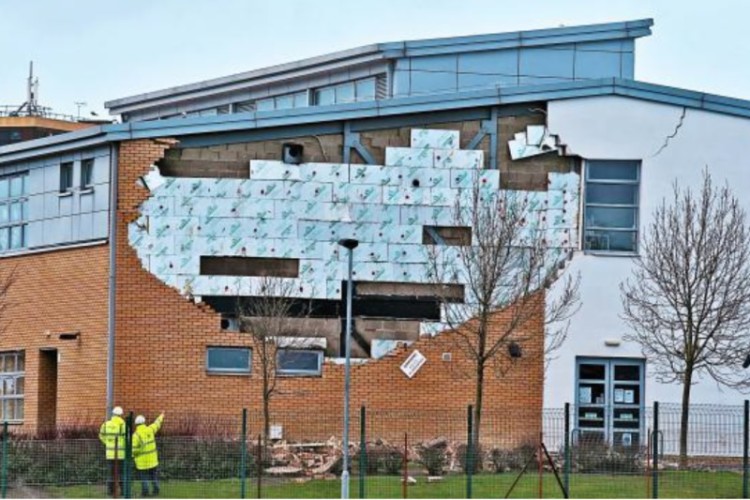The revelation comes in a BBC Scotland investigation1 that asked all of the country's local authorities if repair work involving wall ties or significant structural issues had been done at schools built under PPP or design & build in the past 18 months.
Relevant work was done at 71 schools in 15 local authority areas, in addition to the 17 that had already been disclosed in Edinburgh. The total could be higher than 88 as 11 councils said they had not done full surveys and one – Highland Council – did not respond to freedom of information requests.
In Glasgow 23 schools were found to be flawed. All were built under design & build and 22 of them were PPP schemes.
The primary cause of the collapse of nine tonnes of brickwork from a wall at Oxgangs primary school in January 2016 was poor quality construction in the building of the wall, which failed to achieve the required minimum embedment of 50mm for the wall ties, particularly in the outer leaf of the cavity wall. An independent report into the failure by Professor John Cole, published in February 2017, found that the root cause was poor workmanship that went unchecked. However, the wider systemic cause was deemed to be modern procurement methods – not the use of private money but the elimination of the traditional role of the client’s representative that design & build represents, and the replacement of clerk of works supervision with self-certification.
Cole’s School Closures Report (PDF 3.8MB) said that the poor quality was down to problems with bricklaying, supervision and quality assurance – “All three issues were ultimately the responsibility of the design and build contractor in charge of the site,” Cole said. The use of private finance, per se, was not an issue, he said.
On publication of the Cole report, the Royal Incorporation of Architects in Scotland (RIAS) issued a call to action. RIAS president Willie Watt said: "When major inquiry reports are published there is a tendency for everyone to breathe a sigh of relief, mutter ‘well that's that dealt with’ and move on. That should not be the case with this, extremely well researched and deeply concerning report. The message is simple and the responsibility of all commissioning authorities is clear. An early process of inspection by appropriately qualified experts should proceed as urgently as the various public commissioning authorities, local, health and governmental, can muster the skilled individuals who can do this work.”
Cole also said that there was no reason to suppose the problem was limited to Scottish schools. His report said: “It would, however, be naive to suggest that this is a problem only relating to the construction of schools and that contractors apply a better standard of quality assurance on other building types. If these defects are present in school buildings, there is also a likelihood that they are present with similar frequency in other buildings that contain large masonry panels or where masonry panels are required to be tied back to a structural frame.
.png)
“What is also significant about the Edinburgh situation is that highly professional and competent teams of structural engineers were unable to identify, through detailed visual inspections, the existence of serious defects in the construction of the walls they examined. This point is worthy of wider consideration by those who may have relied on visual inspections as a form of assurance that the underlying construction of walls are sound. Any such inadequacies in the construction of masonry panels, must therefore, be detected prior to walls being closed-up or there is no easy practical way of ensuring they have been built properly. This requires effective quality assurance and scrutiny during construction.”
Professor Cole was also very specific on what industry action was now required. “It is incumbent upon the construction industry to develop and promulgate best practice methods that can be relied upon to provide the necessary level of assurance in relation to those areas of construction that become quickly closed up to inspection, the failure of which could impact on the safety of the users of buildings. In addition to the construction of masonry panels, fire-stopping has been identified in the report as another such area deserving of special attention.
“It is also clear that clients, particularly public sector clients with statutory duties in relation to the communities they serve, cannot simply delegate away from themselves the responsibility of putting in place an appropriate level of informed, independent scrutiny to ensure the safety of the public buildings they procure. By independent scrutiny the Inquiry is referring to inspection by individuals or organisations appointed by or directly employed by the client who are independent of the project company or contractor undertaking the project.
“The exact nature and effectiveness of the role of Building Standards in this regard is also worthy of further review and consideration. The potential extension of the current requirement for formal certification of parts of the work by qualified individuals, as is the case for electrical and plumbing installations, may offer a possible solution to the lack of inspections that Building Standards can practically carry out in relation to elements of the structure or fabric of buildings that could cause injury if not constructed properly.
“Despite the significant increasing reliance being placed on the quality assurance by contractors of their own work, there is no formal requirement for the personnel within contracting organisations charged with undertaking this role to have undergone any recognised test of competency to do so.”
While local authorities in Scotland continue to find defects, the wider UK construction industry has yet to respond. No major industry organisation, not the Construction Industry Council that represents the professional institutions nor Build UK which represents many of the contractors, has yet formulated a response to Professor Cole’s report. Indeed, there is no evidence that they currently intend to.
1. The BBC's report (essential reading) can be found at www.bbc.co.uk/news/uk-scotland-scotland-politics-39580308.
Got a story? Email news@theconstructionindex.co.uk
.png)


